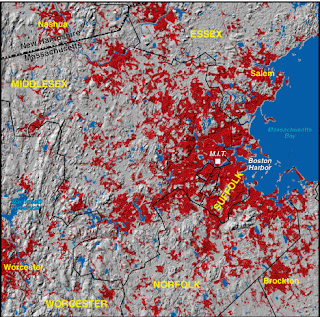Boston, Massachusetts 1973
1970 Population - 4,013,365
Includes Essex, Suffolk, Norfolk, Middlesex, and Worcester Counties. NOTE: portions of the above listed counties may not be visible on the map
Red areas shown as developed land 329,700 acres (515 square miles)
Founded in 1630, Boston is the oldest major metropolitan area in the nation. Because New England was not a prosperous agricultural region, many residents became merchants. By the early 1800s, Boston's ships were trading as far away as China. Irish immigration in the mid-19th century greatly added to the city's population. With the rise of industry, Boston came to specialize in textiles, leather goods, and publishing. Federal research funding to local universities, especially the Massachusetts Institute of Technology (MIT), during and after World War II helped spawn new enterprises. One of the Nation's first "high tech" corridors developed around Route 128, an early beltway highway. Computer and electronic industries flourished, bolstered by MIT graduates and capital from Boston's venerable financial institutions.
Boston, Massachusetts 1992
1990 Population - 4,058,246 Includes Essex, Suffolk, Norfolk, Middlesex, and Worcester Counties. NOTE: portions of the above listed counties may not be visible on the map
Red areas shown as developed land 488,900 acres (764 square miles) Urban growth has had extensive impacts on the entire region. High-tech industries tied to the Federal defense budget have experienced a boom and bust cycle that has greatly influenced housing costs. Land easily developed has become more limited for many reasons, including rising speculative costs, sites reserved for cultural and historic values, and the local physical conditions of slope and soil structure. Land use is strictly regulated in many places, especially around water reservoirs. To escape high taxes, many Boston-area residents and businesses have relocated to New Hampshire.
Megalopolis: Urban growth in Boston, with its harbors, large buildings, and access highways |




No comments:
Post a Comment